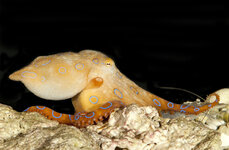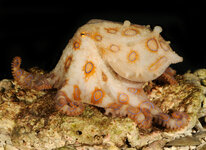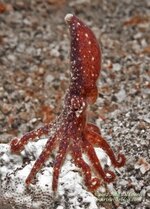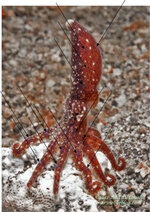- Joined
- Mar 17, 2003
- Messages
- 662
There are currently four described species of blue-ringed octopus (Hapalochlaena). Norman in his book "Cephlapods: A World Guide" figures five additional undescribed species and I've seen a couple of others. While all blue-ringed species that have been examined appear to have TTX, species and even individuals vary considerably in the amount they contain. A blue-ring is not just a blue-ring. Some are definitely more dangerous than others.
One species confirmed to have been responsible for deaths is Norman's species #1 from Northern Australia. The largest of all Hapalochlaena with a mantle length of up to 6 cm, it definitely is toxic - and has the personality to match. While most H. lunulata that I deal with are quite shy and non-aggressive, this species seems much more bold and willing to stand its ground. While I don't recommend that anyone keep blue-rings in their home aquarium, this is definitely one to avoid. It is easy to spot because when excited it turns a deep maroon.
Roy
One species confirmed to have been responsible for deaths is Norman's species #1 from Northern Australia. The largest of all Hapalochlaena with a mantle length of up to 6 cm, it definitely is toxic - and has the personality to match. While most H. lunulata that I deal with are quite shy and non-aggressive, this species seems much more bold and willing to stand its ground. While I don't recommend that anyone keep blue-rings in their home aquarium, this is definitely one to avoid. It is easy to spot because when excited it turns a deep maroon.
Roy




